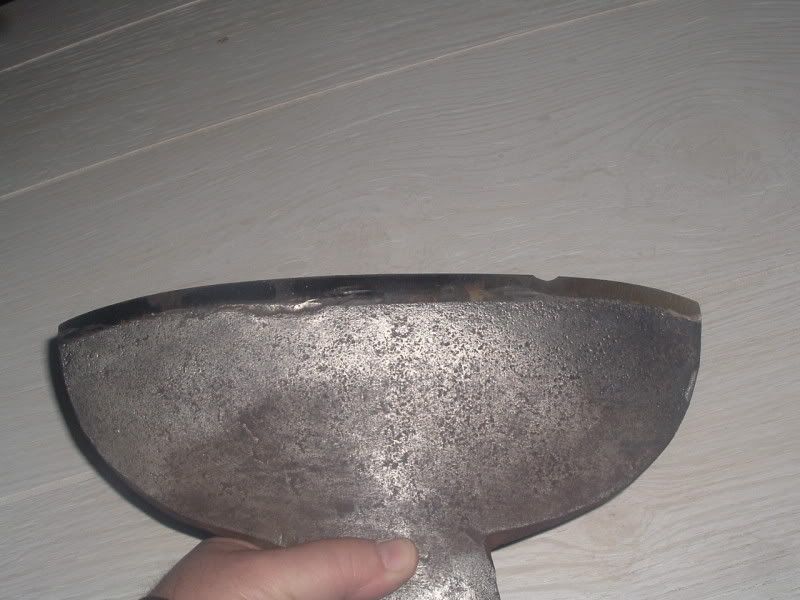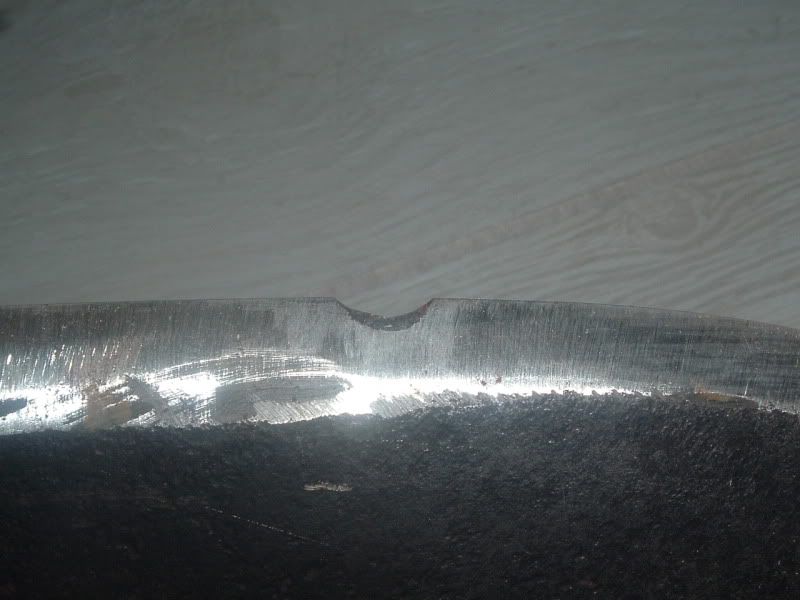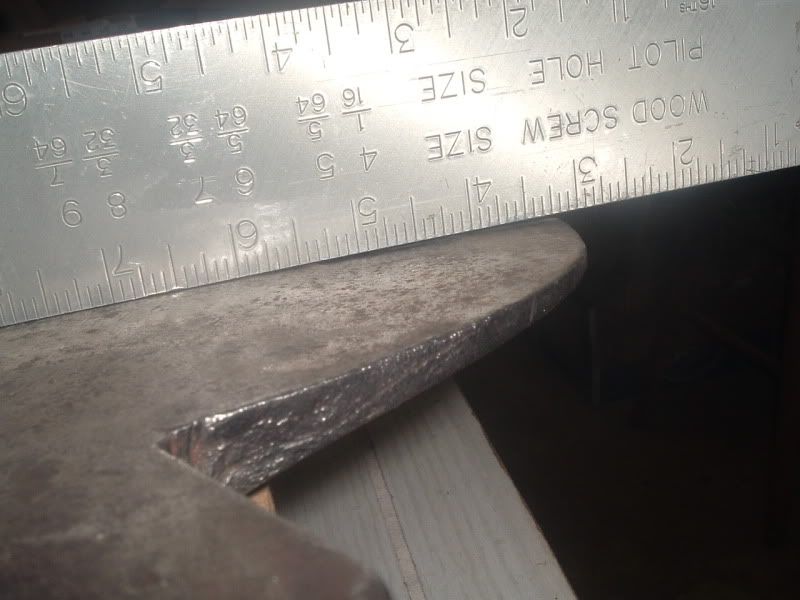|
 Are old broad axes worth buying or not?
#19230
04/15/09 08:11 PM Are old broad axes worth buying or not?
#19230
04/15/09 08:11 PM
|
Joined: Dec 2008
Posts: 49
cedar
 OP
OP
Member
|
OP

Member
Joined: Dec 2008
Posts: 49 |
How are good are old broad axes to buy? Does their metal get brittle over time as can happen in chisels? I have a Granfors broad axe and like it . But I want to get an old broad axe for use in my work. Are heavily rusted broad axes worth buying?
I got some pitting on my new Barr Slick. What could be the best way to remove it? Are Traditional Timber Framers safe on the forum now?
|
|
|
 Re: Are old broad axes worth buying or not?
[Re: cedar]
#19233
04/15/09 09:38 PM Re: Are old broad axes worth buying or not?
[Re: cedar]
#19233
04/15/09 09:38 PM
|
Joined: Mar 2008
Posts: 570
OurBarns1

Member
|

Member
Joined: Mar 2008
Posts: 570 |
Come on over, the weather's fine!
They say electrolysis is a good way to clean heavy rust on old tools. Never done it myself, but here's some info and pictures of the process:
http://users.eastlink.ca/~pspencer/nsaeta/electrolysis.html#setup
Buying old stuff to reuse has a certain romance, even spirit, I suppose... honoring those before. Some say the old steel is better, too.
Don Perkins
Member, TFG
to know the trees...
|
|
|
 Re: Are old broad axes worth buying or not?
[Re: cedar]
#19235
04/15/09 10:12 PM Re: Are old broad axes worth buying or not?
[Re: cedar]
#19235
04/15/09 10:12 PM
|
Joined: Jan 2008
Posts: 918
bmike

Member
|

Member
Joined: Jan 2008
Posts: 918 |
I have a fabulous (and not at all virtual) broad axe that I picked up at a flea market. $60 and the handle was intact. Upon cleaning it up and getting it sharpened it looked to me like the cutting edge was forged into the body, as there are 2 distinct colors where the 2 meet. There is a maker's mark barely visible, and after lots of elbow grease getting the sharp end sharp again it served me just fine for a project or two...
Pitting? Where? On or near the cutting edge? Or on the tool body? 3m Scotchbrite and some WD 40 works well for minor blemishes, or use the 3m pad and the slurry left over from water stone sharpening (usually just slurry from the fine stone...) - but if its near the working edge be careful not to distort the face...
Yes, traditional timber framers are quite safe. Just be sure to back up all your files on a regular basis.
|
|
|
 Re: Are old broad axes worth buying or not?
[Re: bmike]
#19236
04/15/09 10:20 PM Re: Are old broad axes worth buying or not?
[Re: bmike]
#19236
04/15/09 10:20 PM
|
Joined: Mar 2002
Posts: 1,687
Jim Rogers

Member
|

Member
Joined: Mar 2002
Posts: 1,687 |
I have some broad axe heads and one with a handle available. Also, some replacement handles if you need one.
I'll be taking the collection to TTRAG this weekend and having Jack Sobon and Mike Beaudry to inspect and cast an opinion on their condition and value....
Whatever you do, have fun doing it!
|
|
|
 Re: Are old broad axes worth buying or not?
[Re: Jim Rogers]
#19247
04/16/09 12:43 AM Re: Are old broad axes worth buying or not?
[Re: Jim Rogers]
#19247
04/16/09 12:43 AM
|
Joined: Mar 2002
Posts: 1,198
northern hewer

Member
|

Member
Joined: Mar 2002
Posts: 1,198 |
Hi cedar:
There certainly is nothing wrong with a antique broadaxe head providing it has the following characteristics:
--It should have an ample amount of tool steel yet visible along the conjoing line with the more maleable head steel (where the two were forged together in the axe works).
--The cutting edge should be flat on one edge and beveled on the opposite side.
--there should be no noticeable chips on the cutting edge, usually if there has been one you will see where extra filing has taken place
--when you take a file and applying alittle pressure as you push it across the tool steel edge it should not cut into the steel but slide on the surface
--if the tool has a handle in it place it in one of your hands and gently tap the cutting head with a piece of metal, it should ring out like a bell if the tempering is right, if it sounds dead then quickly put it down and move on!!!
I used an antique broadaxe for years it was one that was used in our family for 3 generatons, and could easily go for another 3 with proper care.
One of the worst things that can happen to any wood working tool is for it to stay in contact with mother earth for any extended period of time, it will quickly remove the tempering and make the tool useless.
Another thing that is extremely bad is to overheat the cutting steel usually by applying it against a powered rotating sharpening stone, this friction will heat small areas red hot and make that part real brittle. Usually what happens is that you will see a small particle break away like a cresent moon in shape. Sometimes it will anneal a small area and cause it to not retain a sharp edge. It is best to avoid powered emery stones.
As a final test you should place a straight edge (like a steel square) against the flat side of the blade parallel with the cutting edge, you should notice a slight bit of crown to the flat side at or near the centre line of the blade, this is normal, and is necessary to do good work.
I hope this helps
NH
|
|
|
 Re: Are old broad axes worth buying or not?
[Re: northern hewer]
#19259
04/16/09 01:12 PM Re: Are old broad axes worth buying or not?
[Re: northern hewer]
#19259
04/16/09 01:12 PM
|
Joined: Mar 2002
Posts: 1,687
Jim Rogers

Member
|

Member
Joined: Mar 2002
Posts: 1,687 |
NH: We have this broad axe head:  And it has this small chip out of it:  Also, as you mentioned the back side does have a small curve to it, as shown here:  So, here are my questions to you. What can we do about finishing restoring this axe head? Should we continue to remove metal until this chip is gone? Or is it usable in this condition? Also, I've heard from several different notable sources about what size axe head is the best. One person says a 7" or 8" head is best, and another person says that the 11" or 12" is all they've ever used. Is one size better than the other, and/or is it totally personal preference...? Thanks in advance for your advice. Jim Rogers
Whatever you do, have fun doing it!
|
|
|
 Re: Are old broad axes worth buying or not?
[Re: Jim Rogers]
#19288
04/18/09 12:37 AM Re: Are old broad axes worth buying or not?
[Re: Jim Rogers]
#19288
04/18/09 12:37 AM
|
Joined: Mar 2002
Posts: 1,198
northern hewer

Member
|

Member
Joined: Mar 2002
Posts: 1,198 |
Hi everyone
Well Jim for starters I would look very closely at the axe head to see where the axe is in its useable life is presently, As I look at your picture of the axe, and being it is presented to the readers on its beveled side it is very hard to ascertain how mch tool steel is left.
But from what I can gather it appears that there is not much tool steel left looking at it from this side. If you turn the axe head over you will have a better view of the conjoining line between the tool steel and the mild head steel.
What I would do if there is yet some tool steel left is this:
--make sure the tempering is good
--just file out the chip and make it as good a cutting edge as possible
--Go ahead and use it, eventually the chip will disappear from filing and sharpening the blade, Now you may not see this happen even if you used it every day for the rest of your life but eventually it will disappear
--I use a 10 inch head and this seems to be just right for me and the size of man that i am, now my partner who weighed in at 300+ used a 12 inch broadaxe a much heavier head to raise and use continuously
Personnaly when the axe head gets down to 7 or 8 inches in width in my books it is not a suitable width, these axes were not meant for men to use maybe boys. Most men that I knew could easily use 10 inch heads and up in width.
Some really small men were quite strong in their arms and could hold their own with larger men when it comes to strength and using their arms.
Here i am getting carried away again getting back to your question
I would take emery cloths and wd40 and keep polishing the head to get a good patina on the surface of the steel, then for storage wipe on a light coat of machine oil.
I hope this helps,
NH
|
|
|
 Re: Are old broad axes worth buying or not?
[Re: northern hewer]
#19311
04/20/09 01:27 PM Re: Are old broad axes worth buying or not?
[Re: northern hewer]
#19311
04/20/09 01:27 PM
|
Joined: Mar 2002
Posts: 1,687
Jim Rogers

Member
|

Member
Joined: Mar 2002
Posts: 1,687 |
Thanks for your comments.
I showed the axe head to a fellow doing a hewing demonstration at the TTRAG event this past weekend.
He suggested the head should be sharpened back to remove the chip as it will create a tear at this chip point when it is used to hew a timber.
Some by standers suggested that this tear could be used as a signature mark on the timbers to show who hewed it, when the frame was inspected years in the future.
Jim Rogers
Whatever you do, have fun doing it!
|
|
|
 Re: Are old broad axes worth buying or not?
[Re: Jim Rogers]
#19343
04/21/09 11:17 PM Re: Are old broad axes worth buying or not?
[Re: Jim Rogers]
#19343
04/21/09 11:17 PM
|
Joined: Dec 2008
Posts: 49
cedar
 OP
OP
Member
|
OP

Member
Joined: Dec 2008
Posts: 49 |
The pitting on my new Barr slick is on the neck where the handle goes in. There is more pitting on the face of the slick too. I got the rust out. My cat engraved it for me!!!! Good thing I love my Persian female kitty!!! She is my shop and truck mascot. How can I get the pitting out of the slick? My wife got me the Barr slick as a gift. So anything I could do to fix it up would be helpful.
Thx. Eric
|
|
|
 Re: Are old broad axes worth buying or not?
[Re: cedar]
#19352
04/22/09 12:57 PM Re: Are old broad axes worth buying or not?
[Re: cedar]
#19352
04/22/09 12:57 PM
|
Joined: Jan 2008
Posts: 918
bmike

Member
|

Member
Joined: Jan 2008
Posts: 918 |
The pitting if deep probably won't come out unless you surface a wide area... is the 'face' on the flat cutting side, or top side? I wouldn't worry about it if it doesn't affect the function of the tool. And be sure to remind kitty that tool boxes are not litter boxes... 
|
|
|
|
|